If you’re looking to grill onboard, you’re likely going to buy a BBQ that runs off of propane. Even though marine cockpit-mounted barbecues used charcoal decades ago, the norm is propane today, but of course you can keep it old school. If you keep a charcoal version on board, it’s wise to wrap the grill after each use in a large plastic garbage bag to keep ash and grease from contaminating the other contents of the locker. It’s difficult to keep a barbecue clean.
Magma still offers a charcoal model, which is essentially the same except there is no burner or regulator, but the propane models are more popular. There still will be grease on the grill, but there’s no messy ash to dispose of after dinner. Worse, we hear that, at least in some locations, you’re not supposed to dump the ash into the water, meaning you’d have to let the briquettes totally cool and then empty them into a garbage bag for shoreside disposal. What a pain.
All of the companies making marine barbecues note that their systems can be plumbed to the boat’s large propane tanks. This requires a pressure regulator. While this is a convenient set-up, owners of smaller boats may prefer using the 1-lb. propane bottles commonly found in camp stores. These sell for a few dollars each. All barbecues tested in this report were operated with the 1-lb. propane fuel supply. As reported in our evaluation of single-burner stoves, the American Boat & Yacht Council does not approve of the use or stowage of these 1-lb. propane canisters belowdecks.
EVALUATION CRITERIA
While barbecues seem fairly simple—and it is tempting to just throw a steak on each grill and cook ’em—we found there’s more to designing and manufacturing a barbecue than meets the eye.
In our evaluation, we examined materials for resistance to the harsh marine environment and for long-lasting finish, design elements such as ventilation for convection cooking, ease of lid removal, ease of cleaning, ease of mounting and dismounting, burner design for evenness of cooking and flame control, and mounting options. In the end, we did grill some burgers on each and “baked” a square of pizza dough as a measure of evenness of heating. In the case of the burgers, we learned more about the grills trying to clean up the mess than we did cooking.
FORCE 10

This well-known maker of stainless steel marine equipment is based in British Columbia, Canada. Force 10 used to make three models of marine barbecues, a large and small cylinder type, and the round kettle type. The test model is #83720, the large 9-1/2″ diameter cylinder type. However, this model is no longer available. In 2006, Force 10 split into three divisions (Galley Cooking, BBQ and Water Heaters, and Cabin Heaters), their BBQ division was sold to Kuuma and Force 10-branded grills went off the market in 2008. The Galley Cooking division was sold to ENO France and and the North American division was re-named Force 10 Appliances. That group, which makes the well-known gas gimbal stoves, reentered the grill market in 2018 with their marine BBQ called the Cook N’ Boat Gas BBQ, which is slightly larger than the grill we tested. While this review is for the old Force 10 model, you’ll find info about the new Force 10 in the “Bottom Line” section.
The Force 10 #83720 is made of type 304 stainless steel. The front handle, which has a nice spring coil to keep your hand from getting burned, is brass. So is the name plate, the knurled mounting knobs underneath, and a few machined pieces in the lid mechanism, which cleverly rolls back around the cylinder on four pivoting arms. In this manner it avoids having to be hinged with a lid that would stand up and scoop air.
The burner is an inch-diameter tube that runs the length of the cylinder and has lots of small holes for the flame to come out. Heat is spread by a corrugated steel plate with rows of half-inch holes. Both the grill and heat spreader are removable for cleaning. Grease drippings find their way to the bottom of the cylinder where they drain into a drip pan that slides out to one side for cleaning. The round body carries grease away better than flat bottoms. The drip pan is thoughtfully tethered to the unit so you don’t lose it overboard, but the wire is very thin and pulled out of the Nicopress-type clamp.
Vents are found on both ends of the cylinder and have a small ear-like handle to open and close them. They cannot be closed all of the way because barbecue grills require some air intake for convection and to prevent getting too smoky. Cooking with the lid off or open results in longer cook times.
Wind is the enemy of outdoor grills, and we were fortunate to have a brisk breeze during the cook-out. The Force 10 initially gave us trouble staying lit at the high setting. Turning the gas regulator slightly down cured the problem. The rollaway lid is easy to operate for checking food for doneness. A major convenience of the cylindrical or box-type grills is that when trying to slip a spatula under a burger or other food you want to turn over, there are back and side walls against which to push the patty. Try this with a kettle type grill and you can end up pushing the burger right off the cooking surface into the water or cockpit. You need a stopper in your other hand.
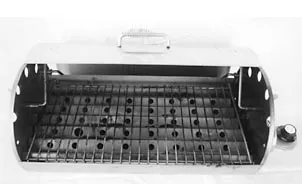
After the grills cooled, we set about cleaning them. It’s not a pleasant job. Most of the grease never makes it to the drip pan, collecting instead on the interior walls of the grill. The Force 10 was relatively easy to disassemble and clean.
Next we “baked” pizza dough on all of the grills to check for evenness of heat. We did not notice great differences among the grills, so it appears that the compact marine barbecue grill has evolved to the point that hot and cold spots aren’t as much of a problem as earlier models. The Force 10 heated the dough evenly.
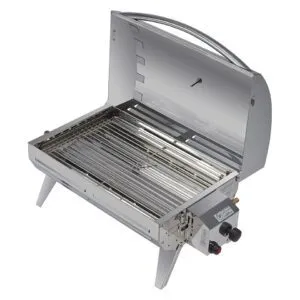
Bottom Line: The discontinued Force 10 is perhaps the most finely crafted of the grills we tested. Parts fit with close tolerances and machining seems superior. It, along with the other brushed stainless grills, retained its appearance better than the polished lids of the kettle-type grills, which were discolored after use. While not quite as big as the Dickinson Sea-B-Que, if you can find a Force 10 grill second-hand, it will be worth the buy and will likely be more affordable than a $470 Dickinson. The online forum consensus is that Kuuma’s are decent but not as well-built as the Force 10.
The new Force 10 Cook N’ Boat model costs around $649, making it more expensive than the Magma and the Dickinson. That higher price speaks to the quality and longevity of the grill, Brad Clark, VP of Force 10, explained to Practical Sailor. Clark wrote that Force 10 is responding to market demand “for a quality BBQ that would last more than just one or two seasons.” We are confident recommending the quality and longevity of the grill since it is manufactured by the same folks who make the Force 10 gimbal stoves.
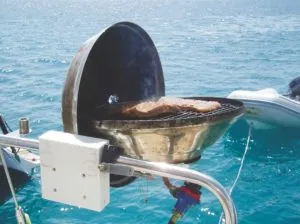
MAGMA MARINE KETTLE
One of the most commonly seen marine barbecues, the Magma Marine Kettle is a round, double-wall design with a lid that can be hung on the grill body at any location. A washer inside on the lid handle bolt cleverly holds the lid.
Several sizes of the Marine Kettle are available, including the “Original Size” (#A10-007) and “Party Size”(A10-017). We tested the smaller of these two, which has a cooking surface measuring 133 square inches, compared to the larger one at 204 square inches. Other styles offered include charcoal models and a gas one that has a “radiant screen and ceramic briquets” in place of the patented “radiant burner plate and dome system.”
Construction is 18-9 spun stainless steel that is polished and hand-finished for a shiny surface. To ignite, an electronic gas grill igniter is recommended. Owners are cautioned not to drop a lighted match through the lid’s vent holes. Good advice. Because of the danger of gas build-up, never light a grill with the lid on.
Magma’s “radiant burner plate and dome system” allows you to remove the normal grill that you would put meat on, and place standard pots and pans on the three-finger burner plate. The idea is to give the standard barbecue more versatility by enabling you to do other sorts of cooking as well, such as boiling water or pan frying. Whether you find this an important feature probably depends on what sort of stove, if any, you have below. On a small boat, a versatile barbecue would be helpful; on a larger boat, with a stove/oven combo in the galley, being able to boil water in the cockpit isn’t a big deal. But we did try pots and pans on the Magma and it does work as advertised.
Magma makes a very complete line of mounts (rail, deck socket, fish rod holder, shore stand and more) and accessories, including Sunbrella covers, cookware, a fish and veggie grill tray, canister storage bag and a variety of polyethylene serving and cutting tables that give you a sort of countertop next to the grill.
The Magma has vent holes in the lid that are not adjustable. Like the others, the Magma is designed to be used with the lid on. The 11,000 Btu burner is round and connects to a venturi tube that rotates 360° for convenience in hanging the gas bottle.
Grease is collected in a pan at the bottom; to clean it thoroughly you have to take apart the grill.
In operation, the Magma was the only grill that wouldn’t stay lit during the burger test. It’s not clear whether the wind caused this or some other factor. We like Magma’s adjustable gas regulator, which lets you orient the gas bottle in any direction. When used on its feet on the ground, this lets you lay the bottle on its side, rather than having to elevate the grill so the bottle can hang down, as with the other grills tested.
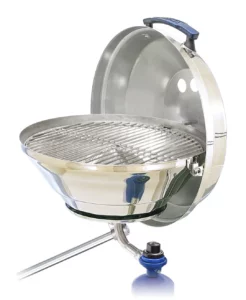
In baking the pizza dough, the grill grew hot much faster than the others, probably because of its 11,000 Btu burner and smaller size. Consequently, the bread burst into flame and soon was reduced to ash. Obviously we should have turned down the flame, but we were “baking” on all five stoves at the same time, so that conditions (ambient temperature and wind speed) would be the same for all, and, hey, we just didn’t check it fast enough. Anyway, judging from the red glow of the flame spreader, heat is very uniform across the cooking surface.
Bottom Line: The Magma is available with the widest range of accessories. It looks great when new, but like the other kettle types, tends to become more discolored after use than the brushed finishes. The 11,000 Btu burner needs to be watched, but will be appreciated when cooking on a windy day. Keep it clean with tester-favorite Weber Grate Grill cleaner and/or a wire brush.
DICKINSON SEA-B-QUE

Dickinson, perhaps better known as the maker of stainless steel cabin heaters, also makes a cylindrical barbecue grill in small and large sizes. The large model has angular lids rather than the round lid of the Force 10.
The Dickinson has a few features the others lack: a thermometer on front and wooden lift handles. There’s also a handsome brass name plate on the front. Other standard features include metal feet (that appear to be black anodized aluminum) with studs for the optional rail mount, an igniter and a corrugated stainless cook surface. There is a convenient grease tray removable from the front. The grill vents between the lid and body are in the back. There are no adjustable vent holes. The long burner has a built-in flame spreader welded on top. Like all of the other grills, the gas regulator has an on/off feature and variable flame settings.
Construction is polished stainless steel. The small welds on our grill show a faint bit of rust. More assembly is required than with other models. The manual has minimal instructions and crude computer drawings. While the unit went together fine, we would have appreciated some advice, like installing the igniter before the burner, because the latter got in the way.
In operation, the Sea-B-Que performed very well, with hot, even heat. We forgot to spray Pam on the corrugated stainless steel cooking surface and so had a lot of meat stick to it We’re not sure what the statement in the Defender catalog means when it says, “unique non-stick, no flare cooking surface.” The plates are easy to remove and wash, however.
The Sea-B-Que has a piezo igniter but in our experience these are not always reliable, so we don’t mind using one of those special purpose gas grill lighters, which lights every time.
The Sea-B-Que did a decent job grilling the burgers and demonstrated evenness baking the bread, though the later was blackened on the bottom, which is when we noticed that its cooking surface is closer to the burner than on the Force 10 grill. With the pizza dough, this appears to be a liability, but on a cold, windy day, it might just as easily be an asset.
Bottom Line. The Sea-B-Que is the heaviest of the grills tested. The thermometer is a nice feature. The rusty welds are a worry, but none of these grills is likely to retain its shiny new appearance for long.
Conclusion
There’s a basic dichotomy between the kettle and cylindrical-style grills: light weight, versatility (pots and pans) and compactness versus larger, rectangular cooking surfaces. Therefore, it seems sensible to recommend the kettle grills for smaller boats and the cylindrical grills for larger boats, which can tolerate the weight and have the room to stow them in a locker.
We were impressed with the overall quality of the group.
Magma is a reliable choice for the kettle types. It has also has a large line of accessories, if that is important to you. Its lid is removable and can be positioned at any place around the grill to block the wind while you work.
The Force 10 model that we tested used to be the least expensive (imagine that!) of the cylindrical or box-type grills and very nicely made. Then again, so are the Dickinson Sea-B-Que, which is larger and correspondingly more expensive.
If we had to choose between all three grills, regardless of type, the old Force 10 has our preferred rectangular cooking surface and quality parts and craftsmanship. Although this model is discontinued, you could get a good run out of a second-hand find but long term you won’t be able to replace parts. If you’d like to spend more and try out their new Cook N’ Boat grill, that is also a safe bet due to the company’s high-quality gimbal stoves.
There’s also new electric grills on the scene like the fancy Kenyon Marine version. Folks on the sailing forums like them but need to either run them while plugged into shore power or run the generator. For now, the propane grills are more affordable and offer folks more flexibility if they don’t want to run their generator in a quiet anchorage. It will be interesting to see how the electric grill offerings develop.
Contacts— Dickinson, www.dickinsonmarine.com. Force 10 Marine, www.force10.com. Magma Products, www.magmaproducts.com.


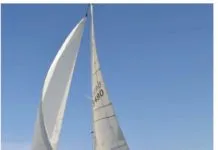

































I have the party sized Magma kettle. I am happy with it and have not had the wind blow out problem reported in the article. The unit has a built in pizzo electric sparker which has not failed after five years of use. The fitting at the bottom that holds the adjustable gas feed tube loosens easily and needs watching. Food cooks well with the flame adjuster set well below high.
I have the Magma kettle and don’t like it at all. Gets too hot, the piezo electric spark no longer works and overall it’s too small. I’ve used the Dickenson on a friend’s boat a few times and while it’s a good unit I think I can do better buying a similar format style at a big box store for less money. Other boaters I know have saved money and enjoy their BBQing just as much.